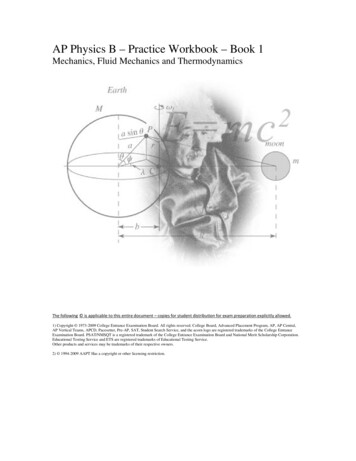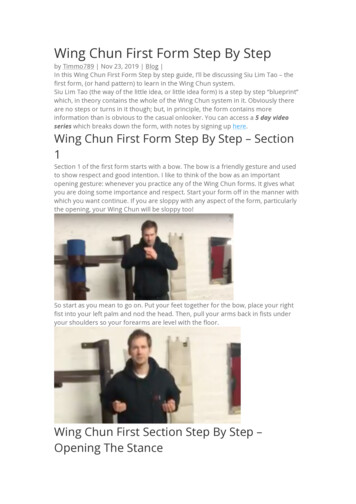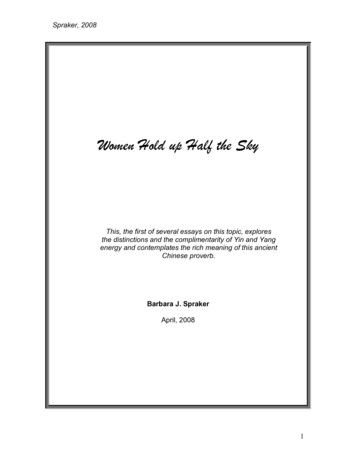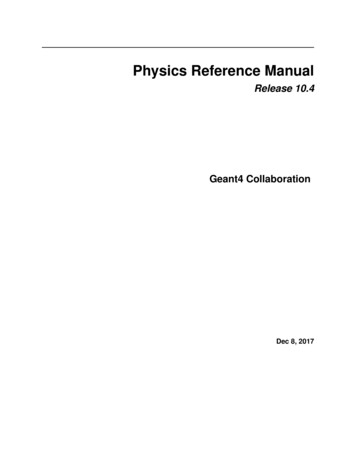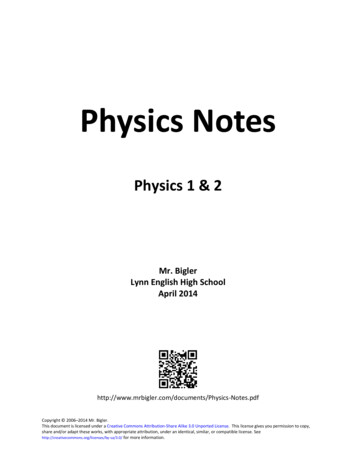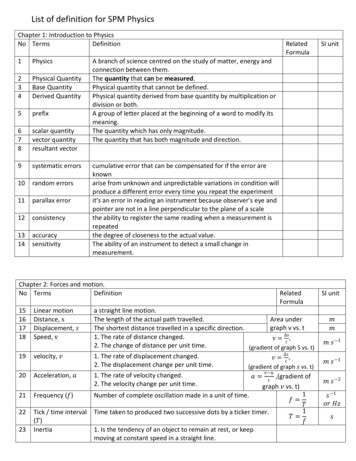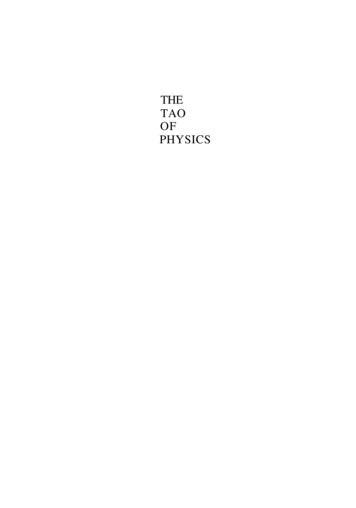
Transcription
THETAOOFPHYSICS
Shambhala Publications, Inc.1123 Spruce StreetBoulder, Colorado 803020 1975 by Fritjof Capra. All Rights Reserved.ISBN: o-87773-077-6 (cloth)o-87773-078-4 (paper)LCC: 75-10318Distributed in the United States by Random House, inc.Manufactured in the United States of America
THETAOOFPHYSICSAn Exploration of the ParallelsBetween Modern Physicsad Eastern Mysticismby Frifjof CapraShambhalaBoulderl1975
I dedicate this book toAli Akbar KhanCarlos CastanedaGeoffrey ChewJohn ColtraneWerner HeisenbergKrishnamurtiLiu Hsiu Ch’iPhiroz MehtaJerry Shesko8obby SmithMaria Teuff enbachAlan Wattsfor helping me to find my pathand to Jacquelinewho has travelled with meon this pathmost of the time.
ACKNOWLEDGEMENTSThe author and publisher gratefully acknowledge permissionto reproduce copyright illustrations on the following pages:pp. 14-15: Fermi National Laboratory, Batavia, Illinois;p. 38: Foto Gary Elliott Burke;pp. 52-53,79, 234, 236: CERN, Geneva, Switzerland;pp. 82-83: reprinted from Zazen by E. M. Hooykaas and B.Schierbeck, Omen Press, Tucson, Arizona;pp. 84,148: Estate of Eliot Elisofon;p. 91: Gunvor Moitessier;p. 92: reprinted from The Evolution of the Buddha Image byBenjamin Rowland Jr., The Asia Society, New York;pp. 100,112,188: Gulbenkian Museum of Oriental Art;pp. 120, 258: r eprinted from Zen and lapanese Culture byD. T Suzuki, Bollingen Series LXIV, by permission of Princeton University Press;p.134: reprinted from Physics in the Twentieth Century byVictor Weisskopf, M.I.T. Press, Cambridge, Massachusetts;p. 144: Nordisk Pressefoto, Copenhagen, Denmark;p. 195: Hale Observatories, Pasadena, California;pp. 202, 206, 224, 233, 237, 267: Lawrence Berkeley Laboratory,Berkeley, California;pp. 230, 232: Argonne National Laboratory, Argonne, Illinois;p. 243: reprinted from The Arts of India by Ajit Mookerjee,Thames and Hudson, London.p. 284: Clinton S. Bond/BBM.
CONTENTSPreface11I THE WAY OF PHYSICS1 Modern Physics-A Path with a Heart?2 Knowing and Seeing3 Beyond Language4 The New Physics17264552II THE WAY OF EASTERN MYSTICISM5 Hinduism6 Buddhism7 Chinese Thought8 Taoism9 Zen8593101113121III THE PARALLELS1011The Unity of All ThingsBeyond the World of 8512131415161718Space-TimeThe Dynamic UniverseEmptiness and FormThe Cosmic DanceQuark Symmetries-A New Koan!Patterns of ChangeEpilogue303Notes309Bibliography317Index321
It is probably true quite generally that in the history of humanthinking the most fruitful developments frequently take placeat those points where two different lines of thought meet.These lines may have their roots in quite different parts ofhuman culture, in different times or different cultural environments or different religious traditions: hence if they actuallymeet, that is, if they are at least so much related to each otherthat a real interaction can take place, then one may hope thatnew and interesting developments may follow.Werner Heisenberg
PREFACEFive years ago, I had a beautiful experience which set me on aroad that has led to the writing of this book. I was sitting bythe ocean one late summer afternoon, watching the wavesrolling in and feeling the rhythm of my breathing, when Isuddenly became aware of my whole environment as beingengaged in a gigantic cosmic dance. Being a physicist, I knewthat the sand, rocks, water and air around me were made ofvibrating molecules and atoms, and that these consisted ofparticles which interacted with one another by creating anddestroying other particles. I knew also that the Earth’s atmosphere was continually bombarded by showers of ‘cosmic rays’,particles of high energy undergoing multiple collisions as theypenetrated the air. All this was familiar to me from my researchin high-energy physics, but until that moment I had onlyexperienced it through graphs, diagrams and mathematicaltheories. As I sat on that beach my former experiences came tolife; I ‘saw’ cascades of energy coming down from outer space,in which particles were created and destroyed in rhythmicpulses; I ‘saw’ the atoms of the elements and those of my bodyparticipating in this cosmic dance of energy; I felt its rhythmand I ‘heard’ its sound, and at that moment I knew that thiswas the Dance of Shiva, the Lord of Dancers worshipped bythe Hindus.I had gone through a long training in theoretical physicsand had done several years of research. At the same time, Ihad become very interested in Eastern mysticism and hadbegun to see the parallels to modern physics. I was particularlyattracted to the puzzling aspects of Zen which reminded meof the puzzles in quantum theory. At first, however, relating
12TheTao ofPhysicsthe two was a purely intellectual exercise. To overcome thegap between rational, analytical thinking and the meditativeexperience of mystical truth, was, and still is, very difficult forme.In the beginning, I was helped on my way by ‘power plants’which showed me how the mind can flow freely; how spiritualinsights come on their own, without any effort, emerging fromthedepth of consciousness. I rememberthefirst such experience.Coming, as it did, after years of detailed analytical thinking, itwas so overwhelming that I burst into tears, at the same time,not unlike Castaneda, pouring out my impressions on to apiece of paper.Later came the experience of the Dance of Shiva which Ihave tried to capture in the photomontage shown on page 224.It was followed by many similar experiences which helped megradually to realize that a consistent view of the world isbeginning to emerge from modern physics which is harmoniouswith ancient Eastern wisdom. I took many notes over the years,and wrote a few articles about the parallels I kept discovering,until I finally summarized my experiences in the present book.This book is intended for the general reader with an interestin Eastern mysticism who need not necessarily know anythingabout physics. I have tried to present the main concepts andtheories of modern physics without any mathematics and innon-technical language, although a few paragraphs may stillappear difficult to the layperson at first reading. The technicalterms I had to introduce are all defined where they appearfor the first time and are listed in the index at the end of thebook.I also hope to find among my readers many physicists withan interest in the philosophical aspects of physics, who haveas yet not come in contact with the religious philosophies ofthe East. They will find that Eastern mysticism provides aconsistent and beautiful philosophical framework which canaccommodate our most advanced theories of the physicalworld.As far as the contents of the book are concerned, the readermay feel a certain lack of balance between the presentation ofscientific and mystical thought. Throughout the book, his orher understanding of physics should progress steadily, but a
comparable progression in the understanding of Easternmysticism may not occur. This seems unavoidable, as mysticismis, above all, an experience that cannot be learned from books.A deeper understanding of any mystical tradition can only befelt when one decides to become actively involved in it. All Ican hope to do is to generate the feeling that such an involvement would be highly rewarding.During the writing of this book, my own understanding ofEastern thought has deepened considerably. For this I amindebted to two men who come from the East. I am profoundlygrateful to Phiroz Mehta for opening my eyes to many aspectsof Indian mysticism, and to my T’ai Chi master Liu Hsiu Ch’i forintroducing me to living Taoism.It is impossible to mention the names of everyone-scientists,artists, students, and friends-who have helped me formulatemy ideas in stimulating discussions. I feel, however, that I owespecial thanks to Graham Alexander, Jonathan Ashmore,Stratford Caldecott, Lyn Gambles, Sonia Newby, Ray Rivers,Joel Scherk, George Sudarshan, and-last but not least-RyanThomas.Finally, I am indebted to Mrs Pauly Bauer-Ynnhof of Viennafor her generous financial support at a time when it wasneeded most.London,Fritjof Cap-aDecember 197413Preface
Any path is only a path, and there is no affront, to oneselfor to others, in dropping it if that is what your heart tellsyou . . . Look at every path closely and deliberately. Try itas many times as you think necessary. Then ask yourself,and yourself alone, one question . . . Does this path havea heart? If it does, the path is good; if it doesn’t it is of nouse.Carfos Castaneda, The Teachings of Don juan.
1 MODERNPHYSICSA Path with a Heart?Modern physics has had a profound influence on almost allaspects of human society. It has become the basis of naturalscience, and the combination of natural and technical sciencehas fundamentally changed the conditions of life on our earth,both in beneficial and detrimental ways. Today, there is hardlyan industry that does not make use of the results of atomicphysics, and the influence these have had on the politicalstructure of the world through their application to atomicweaponry is well known. However, the influence of modernphysics goes beyond technology. It extends to the realm ofthought and culture where it has led to a deep revision inman’s conception of the universe and his relation to it. Theexploration of the atomic and subatomic world in the twentiethcentury has revealed an unsuspected limitation of classicalideas, and has necessitated a radical revision of many of ourbasic concepts. The concept of matter in subatomic physics,for example, is totally different from the traditional idea of amaterial substance in classical physics. The same is true forconcepts like space, time, or cause and effect. These concepts,however, are fundamental to our outlook on the world aroundus and with their radical transformation our whole world viewhas begun to change.These changes, brought about by modern physics, havebeen widely discussed by physicists and by philosphers overthe past decades, but very seldom has it been realized thatthey all seem to lead in the same direction, towards a view ofthe world which is very similar to the views held in Easternmysticism. The concepts of modern physics often show surprising parallels to the ideas expressed in the religious philo-
18TheTao ofPhysicssophies of the Far East. Although these parallels have not, asyet, been discussed extensively, they have been noticed bysome of the great physicists of our century when they came incontact with Far Eastern culture during their lecture tours toIndia, China and Japan. The following three quotations serveas examples :The general notions about human understanding . . . whichare illustrated by discoveries in atomic physics are not inthe nature of things wholly unfamiliar, wholly unheard of,or new. Even in our own culture they have a history, andin Buddhist and Hindu thought a more considerable andcentral place. What we shall find is an exemplification, anencouragement, and a refinement of old wisdom.’julius Robert OppenheimerFor a parallel to the lesson of atomic theory . . . [we mustturn1 to those kinds of epistemological problems withwhich already thinkers like the Buddha and Lao Tzu havebeen confronted, when trying to harmonize our position asspectators and actors in the great drama of existence.*Me/s BohrThe great scientific contribution in theoretical physicsthat has come from Japan since the last war may be anindication of a certain relationship between philosophicalideas in the tradition of the Far East and the philosophicalsubstance of quantum theory.3Werner HeisenbergThe purpose of this book is to explore this relationshipbetween the concepts of modern physics and the basic ideasin the philosophical and religious traditions of the Far East.We shall see how the two foundations of twentieth-centuryphysics-quantum theory and relativity theory-both forceus to see the world very much in the way a Hindu, Buddhistor Taoist sees it, and how this similarity strengthens when welook at the recent attempts to combine these two theoriesin order to describe the phenomena of the submicroscopicworld: the properties and interactions of the subatomicparticles of which all matter is made. Here the parallels between
modern physics and Eastern mysticism are most striking, andwe shall often encounter statements where it is almost impossible to say whether they have been made by physicistsor by Eastern mystics.When I refer to ‘Eastern mysticism’, I mean the religiousphilosophies of Hinduism, Buddhism and Taoism. Althoughthese comprise a vast number of subtly interwoven spiritualdisciplines and philosophical systems, the basic features oftheir world view are the same. This view is not limited to theEast, but can be found to some degree in all mystically orientedphilosophies. The argument of this book could therefore bephrased more generally, by saying that modern physics leadsus to a view of the world which is very similar to the viewsheld by mystics of all ages and traditions. Mystical traditionsare present in all religions, and mystical elements can be foundin many schools of Western philosophy. The parallels to modernphysics appear not only in the Vedas of Hinduism, in the IU-ring, or in the Buddhist sutras, but also in the fragments ofHeraclitus, in the Sufism of Ibn Arabi, or in the teachings ofthe Yaqui sorcerer Don Juan. The difference between Easternand Western mysticism is that mystical schools have alwaysplayed a marginal role in the West, whereas they constitutethe mainstream of Eastern philosophical and religious thought.I shall therefore, for the sake of simplicity, talk about the‘Eastern world view’ and shall only occasionally mention othersources of mystical thought.If physics leads us today to a world view which is essentiallymystical, it returns, in a way, to its beginning, 2,500 years ago.It is interesting to follow the evolution of Western sciencealong its spiral path, starting from the mystical philosophies ofthe early Greeks, rising and unfolding in an impressive development of intellectual thought that increasingly turned awayfrom its mystical origins to develop a world view which is insharp contrast to that of the Far East. In its most recent stages,Western science is finally overcoming this view and comingback to those of the early Creek and the Eastern philosophies.This time, however, it is not only based on intuition, but alsoon experiments of great precision and sophistication, and ona rigorous and consistent mathematical formalism.19ModernPhysics
20TheTao ofPhysicsThe roots of physics, as of all Western science, are to befound in the first period of Greek philosophy in the sixthcentury B.C., in a culture where science, philosophy andreligion were not separated. The sages of the Milesian schoolin lonia were not concerned with such distinctions. Their aimwas to discover the essential nature, or real constitution, ofthings which they called ‘physis’. The term ‘physics’ is derivedfrom this Greek word and meant therefore, originally, theendeavour of seeing the essential nature of all things.This, of course, is also the central aim of all mystics, and thephilosophy of the Milesian school did indeed have a strongmystical flavour. The Milesians were called ‘hylozoists’, or‘those who think matter is alive’, by the later Greeks, becausethey saw no distinction between animate and inanimate, spiritand matter. In fact, they did not even have a word for matter,since they saw all forms of existence as manifestations of the‘physis’, endowed with life and spirituality. Thus Thales declaredall things to be full of gods and Anaximander saw the universeas a kind of organism which was supported by ‘pneuma’, thecosmic breath, in the same way as the human body is supportedby air.The monistic and organic view of the Milesians was veryclose to that of ancient Indian and Chinese philosophy, andthe parallels to Eastern thought are even stronger in thephilosophy of Heraclitus of Ephesus. Heraclitus believed in aworld of perpetual change, of eternal ‘Becoming’. For him, allstatic Being was based on deception and his universal principlewas fire, a symbol for the continuous flow and change of allthings. Heraclitus taught that all changes in the world arisefrom the dynamic and cyclic interplay of opposites and hesaw any pair of opposites as a unity. This unity, which containsand transcends all opposing forces, he called the Logos.The split of this unity began with the Eleatic school, whichassumed a Divine Principle standing above all gods and men.This principle was first identified with the unity of the universe,but was later seen as an intelligent and personal God who standsabove the world and directs it. Thus began a trend of thoughtwhich led, ultimately, to the separation of spirit and matterand to a dualism which became characteristic of Westernphilosophy.
A drastic step in this direction was taken by Parmenides ofElea who was in strong opposition to Hera&us. He called hisbasic principle the Being and held that it was unique and invariable. He considered change to be impossible and regardedthe changes we seem to perceive. in the world as mere illusionsof the senses. The concept of an indestructible substance asthe subject of varying properties grew out of this philosophyand became one of the fundamental concepts of Westernthought.In the fifth century B.C., the Greek philosophers tried toovercome the sharp contrast between the views of Parmenidesand Heraclitus. In order to reconcile the idea of unchangeableBeing (of Parmenides) with that of eternal Becoming (of Heraclitus), they assumed that the Being is manifest in certaininvariable substances, the mixture and separation of whichgives rise to the changes in the world. This led to the conceptof the atom, the smallest indivisible unit of matter, whichfound its clearest expression in the philosophy of Leucrppusand Democritus. The Greek atomists drew a clear line betweenspirit and matter, picturing matter as being made of several‘basic building blocks’. These were purely passive and intrinsically dead particles moving in the void. The cause oftheir motion was not explained, but was often associated withexternal forces which were assumed to be of spiritual originand fundamentally different from matter. In subsequentcenturies, this image became an essential element of Westernthought, of the dualism between mind and matter, betweenbody and soul.As the idea of a division between spirit and matter tookhold, the philosophers turned their attention to the spiritualworld, rather than the material, to the human soul and theproblems of ethics. These questions were to occupy Westernthought for more than two thousand years after the culmination of Greek science and culture in the fifth and fourth centuriesB.C. The scientific knowledge of antiquity was systematizedand organized by Aristotle, who created the scheme whichwas to be the basis of the Western view of the universe fortwo thousand years. But Aristotle himself believed that questionsconcerning the human soul and the contemplation of Cod’sperfection were much more valuable than investigations of21ModernPhysics
22TheTao ofPhysicsthe material world. The reason the Aristotelian model of theuniverse remained unchallenged for so long was precisely thislack of interest in the material world, and the strong hold ofthe Christian Church which supported Aristotle’s doctrinesthroughout the Middle Ages.Further development of Western science had to wait untilthe Renaissance, when men began to free themselves fromthe influence of Aristotle and the Church and showed a newinterest in nature. In the late fifteenth century, the study ofnature was approached, for the first time, in a truly scientificspirit and experiments were undertaken to test speculativeideas. As this development was paralleled by a growing interestin mathematics, it finally led to the formulation of properscientific theories, based on experiment and expressed inmathematical language. Galileo was the first to combineempirical knowledge with mathematics and is therefore seenas the father of modern science.The birth of modern science was preceded and accompaniedby a development of philosophical thought which led to anextreme formulation of the spirit/matter dualism. This formulation appeared in the seventeenth century in the philosophyof Rene Descartes who based his view of nature on a fundamental division into two separate and independent realms;that of mind (res cogitans), and that of matter (res extensa).The ‘Cartesian’ division allowed scientists to treat matter asdead and completely separate from themselves, and to seethe material world as a multitude of different objects assembledinto a huge machine. Such a mechanistic world view was heldby Isaac Newton who constructed his mechanics on its basisand made it the foundation of classical physics. From the secondhalf of the seventeenth to the end of the nineteenth century,the mechanistic Newtonian model of the universe dominatedall scientific thought. It was paralleled by the image of amonarchical Cod who ruled the world from above by imposinghis divine law on it. The fundamental laws of nature searchedfor by the scientists were thus seen as the laws of God, invariable and eternal, to which the world was subjected.The philosophy of Descartes was not only important for thedevelopment of classical physics, but also had a tremendous
influence on the general Western way of thinking up to thepresent day. Descartes’ famous sentence ‘Cogito ergo sum’‘I think, therefore I exist’-has led Western man to equate hisidentity with his mind, instead of with his whole organism. Asa consequence of the Cartesian division, most individuals areaware of themselves as isolated egos existing ‘inside’ theirbodies. The mind has been separated from the body and giventhe futile task of controlling it, thus causing an apparent conflict between the conscious will and the involuntary instincts.Each individual has been split up further into a large numberof separate compartments, according to his or her activities,talents, feelings, beliefs, etc., which are engaged in endlessconflicts generating continuous metaphysical confusion andfrustration.This inner fragmentation of man mirrors his view of theworld ‘outside’ which is seen as a multitude of separate objectsand events. The natural environment is treated as if it consistedof separate parts to be exploited by different interest groups.The fragmented view is further extended to society which issplit into different nations, races, religious and political groups.The belief that all these fragments-in ourselves, in our environment and in our society-are really separate can be seen asthe essential reason for the present series of social, ecologicaland cultural crises. It has alienated us from nature and fromour fellow human beings. It has brought a grossly unjustdistribution of natural resources creating economic and politicaldisorder; an ever rising wave of violence, both spontaneousand institutionalized, and an ugly, polluted environment inwhich life has often become physically and mentally unhealthy.The Cartesian division and the mechanistic world view havethus been beneficial and detrimental at the same time. Theywere extremely successful in the development of classicalphysics and technology, but had many adverse consequencesfor our civilization. It is fascinating to see that twentieth-centuryscience, which originated in the Cartesian split and in themechanistic world view, and which indeed only became possiblebecause of such a view, now overcomes this fragmentationand leads back to the idea of unity expressed in the earlyGreek and Eastern philosophies.In contrast to the mechanistic Western view, the Eastern.-23ModernPhysics
24TheTao ofPhysicsview of the world is ‘organic’. For the Eastern mystic, all thingsand events perceived by the senses are interrelated, connected,and are but different aspects or manifestations of the sameultimate reality. Our tendency to divide the perceived worldinto individual and separate things and to experience ourselvesas isolated egos in this world is seen as an illusion which comesfrom our measuring and categorizing mentality. It is calledavidya, or ignorance, in Buddhist philosophy and is seen asthe state of a disturbed mind which has to be overcome:When the mind is disturbed, the multiplicity of things isproduced, but when the mind is quieted, the multiplicityof things disappears.4Although the various schools of Eastern mysticism differ inmany details, they all emphasize the basic unity of the universewhich is the central feature of their teachings. The highest aimfor their followers-whether they are Hindus, Buddhists orTaoists-is to become aware of the unity and mutual interrelation of all things, to transcend the notion of an isolatedindividual self and to identify themselves with the ultimatereality. The emergence of this awareness-known as ‘enlightenmerit’-is not only an intellectual act but is an experiencewhich involves the whole person and is religious in its ultimatenature. For this reason, most Eastern philosophies are essentiallyreligious philosophies.In the Eastern view, then, the division of nature into separateobjects is not fundamental and any such objects have a fluidand ever-changing character. The Eastern world view is therefore intrinsically dynamic and contains time and change asessential features. The cosmos is seen as one inseparablereality-for ever in motion, alive, organic; spiritual and materialat the same time.Since motion and change are essential properties of things,the forces causing the motion are not outside the objects, asin the classical Greek view, but are an intrinsic property ofmatter. Correspondingly, the Eastern image of the Divine isnot that of a ruler who directs the world from above, but of aprinciple that controls everything from within:He who, dwelling in all things,Yet is other than all things,Whom all things do not know,
Whose body all things are,Who controls all things from withinHe is your Soul, the Inner Controller,The Immortal.5The following chapters will show that the basic elements ofthe Eastern world view are also those of the world view emergingfrom modern physics. They are intended to suggest that Easternthought and, more generally, mystical thought provide aconsistent and relevant philosophical background to thetheories of contemporary science; a conception of the worldin which man’s scientific discoveries can be in perfect harmonywith his spiritual aims and religious beliefs. The two basicthemes of this conception are the unity and interrelation of allphenomena and the intrinsically dynamic nature of the universe.The further we penetrate into the submicroscopic world, themore we shall realize how the modern physicist, like the Easternmystic, has come to see the world as a system of inseparable,interacting and ever-moving components with man being anintegral part of this system.The organic, ‘ecological’ world view of the Eastern philosophies is no doubt one of the main reasons for the immensepopularity they have recently gained in the West, especiallyamong young people. In our Western culture, which is stilldominated by the mechanistic, fragmented view of the world,an increasing number of people have seen this as the underlying reason for the widespread dissatisfaction in our society,and many have turned to Eastern ways of liberation. It isinteresting, and perhaps not too surprising, that those who areattracted by Eastern mysticism, who consult the I Ching andpractise Yoga or other forms of meditation, in general have amarked anti-scientific attitude. They tend to see science, andphysics in particular, as an unimaginative, narrow-mindeddiscipline which is responsible for all the evils of moderntechnology.This book aims at improving the image of science by showingthat there is an essential harmony between the spirit of Easternwisdom and Western science. It attempts to suggest thatmodern physics goes far beyond technology, that the wayor Tao-of physics can be a path with a heart, a way to spiritualknowledge. and self-realization.25ModernPhysics
2 KNOWINGANDSEEINGFrom the unreal lead me to the real!From darkness lead me to light!From death lead me to immortality!Brihad-aranyaka UpanishadBefore studying the parallels between modern physics andEastern mysticism, we have to deal with the question of howwe can make any comparison at all between an exact science,expressed in the highly sophisticated language of modernmathematics, and spiritual disciplines which are mainly basedon meditation and insist on the fact that their insights cannotbe communicated verbally.What we want to compare are the statements made byscientists and Eastern mystics about their knowledge of theworld. To establish the proper framework for this comparison,we must firstly ask ourselves what kind of ‘knowledge’ we aretalking about; does the Buddhist monk from Angkor Wat orKyoto mean the same thing by ‘knowledge’ as the physicistfrom Oxford or Berkeley? Secondly, what kind of statements arewe going to compare? What are we going to select from theexperimental data, equations and theories on the one side,and from the religious scriptures, ancient myths, or philosophical treatises on the other? This chapter is intended toclarify these two points: the nature of the knowledge involvedand the language in which this knowledge is expressed.Throughout history, it has been recognized that the humanmind is capable of two kinds of knowledge, or two modes ofconsciousness, which have often been termed the rational and----. - - --
the intuitive, and have traditionally been associated withscience and religion, respectively. In the West, the intuitive,religious type of knowledge is often devalued in favour ofrational, scientific knowledge, whereas the traditional Easternattitude is in general just the opposite. The following
I THE WAY OF PHYSICS 1 Modern Physics-A Path with a Heart?17 2 Knowing and Seeing 26 3 Beyond Language 45 4 The New Physics 52 II THE WAY OF EASTERN MYSTICISM 5 Hinduism 85 6 Buddhism 93 7 Chinese Thought 101 8 Taoism 113 9 Zen 121 III THE PARALLELS 10 The Unity of All Things 130 11 Beyon




